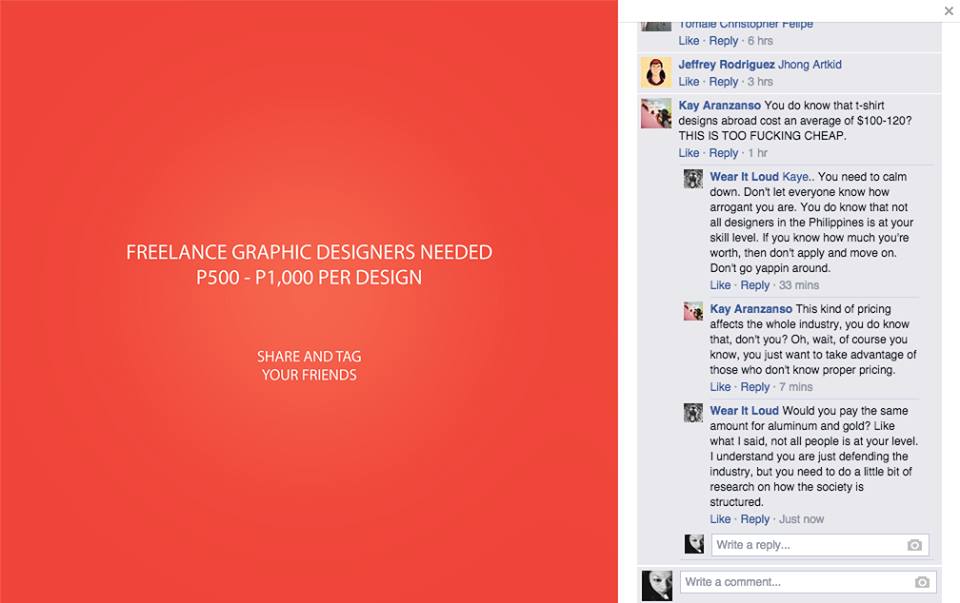
When a client undercharges a hired freelance artist, the effect ripples throughout the industry. And it can get pretty ugly.
A certain clothing brand named Wear It Loud recently released an open call for graphic designers on their now-defunct Facebook page. The ad, in plain text, stated: “Freelance Graphic designers needed. P500 – P1,000 per design.” A call to share the post and tag freelance graphic designers was also at the bottom of the post.
But graphic designer Kay Arazanso of And A Half Design Studio wasn’t having any of it. She was the first to comment and share the post on social media, which ignited a conversation. She said, “You do know that T-shirt designs abroad cost an average of $100-$120? THIS IS TOO FUCKING CHEAP.”
The brand was quick to retort, “If you know how much you’re worth, then don’t apply and move on. Don’t go yapping around.” The most interesting issue on the exchange was then raised by Kay: “This kind of pricing affects the whole industry. You just want to take advantage of those who don’t know proper pricing.”
After several other graphic designers and artists chimed in and shared Kaye’s views, the original post was taken down, and the brand’s Facebook page is now non-existent.
A company looking for cheap labor is nothing new. Unfortunately for Wear It Loud, they took the heat after advertising their blatant disregard for good talent and design. Negotiations between the client and artist about fees are usually done in confidence, and for Wear It Loud to publicly announce the low rates they were willing to pay was pretty incendiary for artists. Even more so when, in their defense, they basically copped to taking advantage of young artists who didn’t know any better.
“Designers, writers, musicians, and all kinds of creative [people] should think about this: Why are we underpaid and undervalued?” Kay asks. “We strive for standards that can compete internationally—we already have the talent and the skills.”
Kay is coming from a standpoint that wants to raise the bar for the design industry—to not settle for any less than the real value of one’s work. “This kind of setup preys on the less informed, the fresh grads, and those who are looking to get exposure and build their portfolios—a cycle that affects the whole industry,” Kay tells Preen.
The problem here is the perception on the clients’ side that graphic design is easy work and with the number of inexperienced design students graduating every year, they can always get it done cheaply. In effect, this mentality could influence how others value design, art, and the livelihood of artists in general. This “change in mindset” is what Kay wants to happen. “What bothered me most was the rate the company was offering, which is, in turn, a reflection of how much value they see in the work.”
While it is true that a freelancer’s rate is mostly dependent on his/her own pricing for a piece of work, a certain industry standard is still at play. For the service the brand was asking for, Kay says the going rate should be roughly around P4,500 to P6,000, which already includes multiple revisions (read: additional work) upon the request of the client.
It is practicality that drives a company to look for cheap labor. But you get what you give. If you’re looking to pay just P500 for a P1,000 job, you should lower your standards accordingly.
Ideally, a fixed standard design rate could really help solve issues like these. But for Bru Sim of Electrolychee, another graphic designer and illustrator, that poses its own challenges. “It is still impossible to apply a fixed standard rate—a ballpark figure could work, though. That’s why we do a per project basis in going about pricing,” she says. Freelance work in the Philippines is still a case-to-case basis.
Yes, people fought a good battle with Wear It Loud by pointing out what was wrong with the premise of their advertisement. But there were still a few commenters that would’ve taken up that offer. It just goes to show that the priorities of freelance artists vary. While some favor the value of their work over anything, others worry more about money—no matter how little but to just get paid—over their craft. It’s a reality, unfortunately, in a third world setting.
But the bigger issue here is more than just negotiating commensurate value for work done. It’s about freelancers putting their foot down and demanding fair rates. If companies can’t get cheap labor, they’ll have no choice but to pay up. This, in turn, elevates the standards of the industry.
It all boils down to how you want things will work out in the long run. When you undermine the value you place on your work, you take everybody else down with you.
So the next time you negotiate freelance work with a company, Kay asks that you keep one thing in mind: “Know your worth.”
As of press time, Wear It Loud has not aired their side of the issue. If a representative of the brand would like to issue a statement, kindly e-mail the author at [email protected].


